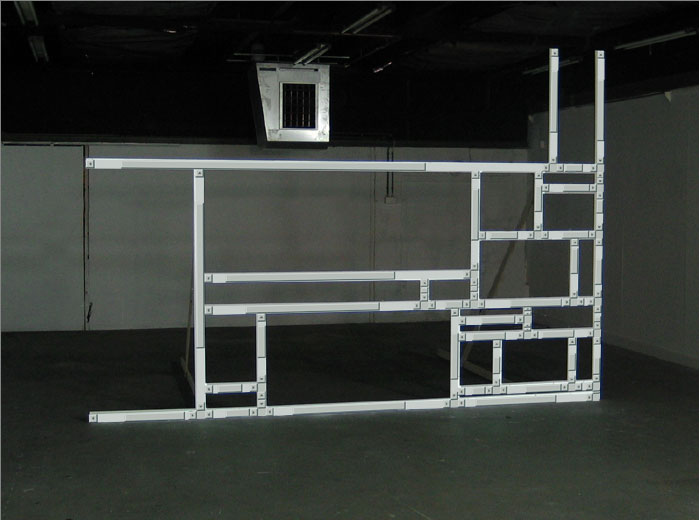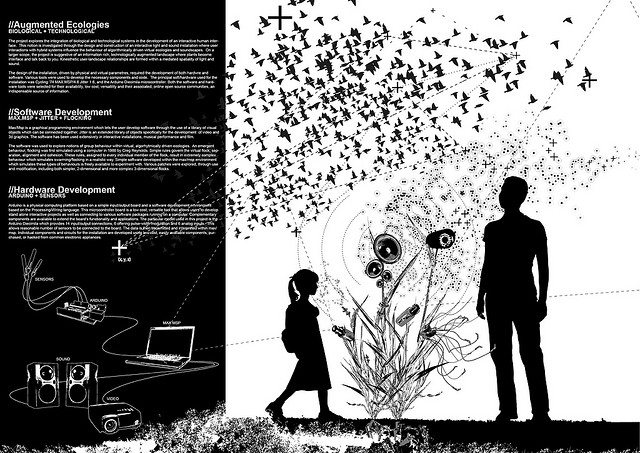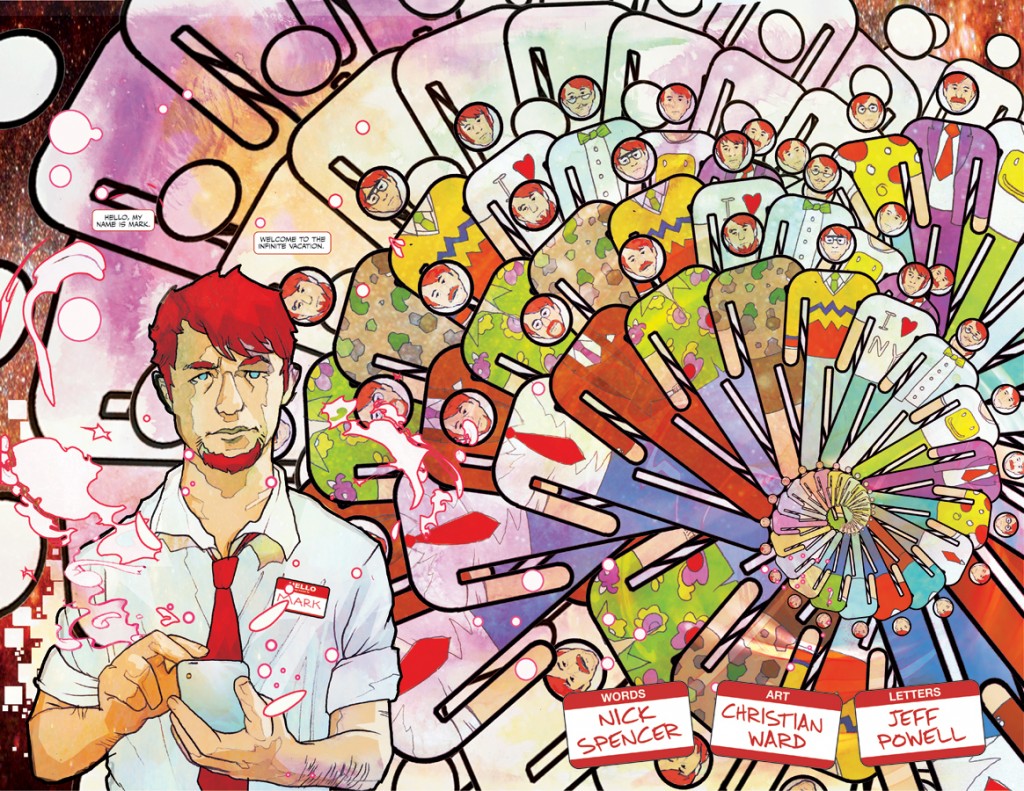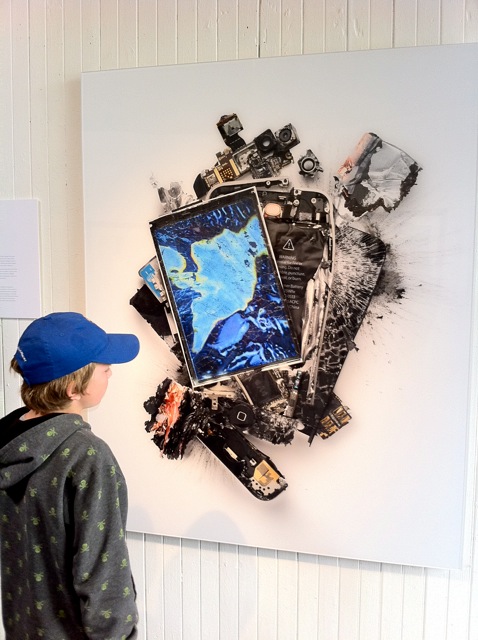 Jan Robert Leegte‘s scrollbars in physical space are another example of augmented reality art. More info and images here.
Jan Robert Leegte‘s scrollbars in physical space are another example of augmented reality art. More info and images here.
art
 I’m a fan of artists using Google Earth or Street View images, such as Jon Rafman’s compelling Street View images or Google’s Street Art View. Here, check out Clement Valla’s “Postcards from Google Earth, Bridges” project. Google Earth renders bridges quite imperfectly, and when these images are shown together, they remind us that Google’s project is not a pure and perfect digital simulation of our world, but, instead, the creation of something new. Something that can be judged aesthetically on its own standards even if they are created as, to quote the artist, “the result of algorithmic processes and not of human aesthetic decision making.”
I’m a fan of artists using Google Earth or Street View images, such as Jon Rafman’s compelling Street View images or Google’s Street Art View. Here, check out Clement Valla’s “Postcards from Google Earth, Bridges” project. Google Earth renders bridges quite imperfectly, and when these images are shown together, they remind us that Google’s project is not a pure and perfect digital simulation of our world, but, instead, the creation of something new. Something that can be judged aesthetically on its own standards even if they are created as, to quote the artist, “the result of algorithmic processes and not of human aesthetic decision making.”
As readers of this blog know well, this new creation born out of the intersection of the physical and digital is what we refer to as “augmented reality.” Sometimes augmented reality is the reality we always find ourselves in: physical, but always and increasingly influenced by digitality. Sometimes this augmented reality is a collection of imperfectly rendered bridges. For me, Valla’s art provocatively reinforces this important theoretical conceptualization.
More augmented reality art: Augmented Ecologies; Siavosh Zabeti’s Facebook book; Michael Tompert’s photography of destroyed Apple products; Aram Bartholl’s embedding USB sticks into public spaces. And all of Valla’s “Postcards from Google Earth, Bridges” are found here.
 The integration of biological and technological systems in the design of an interactive human interface is explored through an installation where plants rigged up with sensors provide a kinesthetic user experience based on movement, touch, sound and light. Human interaction with the system affects an algorithmic projection and soundscape.
The integration of biological and technological systems in the design of an interactive human interface is explored through an installation where plants rigged up with sensors provide a kinesthetic user experience based on movement, touch, sound and light. Human interaction with the system affects an algorithmic projection and soundscape.
More images after the jump. more...
 While the tide is turning, comics are still an under-appreciated medium in 2011. This despite increased interest in superheroes given the Hollywood treatment and critical attention to thoughtful indie pieces like Fun Home and Love and Rockets. It’s a shame because comics’ juxtaposed panels, their special way of framing time in terms of space, are well equipped to address those intersections of identity, technology, and visual representation that get so much play in mainstream and academic press. Image Comics’ Infinite Vacation is one new ongoing title that tackles those ideas head on.
While the tide is turning, comics are still an under-appreciated medium in 2011. This despite increased interest in superheroes given the Hollywood treatment and critical attention to thoughtful indie pieces like Fun Home and Love and Rockets. It’s a shame because comics’ juxtaposed panels, their special way of framing time in terms of space, are well equipped to address those intersections of identity, technology, and visual representation that get so much play in mainstream and academic press. Image Comics’ Infinite Vacation is one new ongoing title that tackles those ideas head on.
Writer Nick Spencer is a rising star whose big hit, Morning Glories, blends teenage drama with the surreal paranoia of 60s TV thriller The Prisoner. In Infinite Vacation, Spencer teams with artist Christian Ward to tell the story of Mark, daily user of a ubiquitous, near-future technology which allows anyone to buy or sell their existence in parallel universes through a smartphone app; for $25,000 Mark can become the hero cop version of himself, and it’ll cost at least $3000 for him to become a Mark who did not just get walked out on by that mystery girl in the coffee shop.
Mark is a cyborg less like Robocop and more like the average Facebook user who presents their preferred self to the world via an array of edited images, clicked “likes”, and comments with friends (i.e., exactly how Cyborgology editors define the cyborg in their inaugural post). Identity definition and presentation through web spaces and consumer devices is a major theme in Infinite Vacation, whether it’s the RSS feed of your alternate selves’ lives and deaths or that mystery girl saying, “That thing in your hand isn’t worth shit to me…” when Mark tries to prove his seriousness by showing how expensive his app-assisted reality purchase would have been. A gorgeous opening spread (below) has infinite Marks fitted into generic male outlines, reminiscent of your chosen profile picture replacing the pale blue Facebook default. more...

Jon Rafman is a Canadian artist who provocatively uses Google Street View images. His project is titled “The Nine Eyes of Google Street View,” named after the Google vehicles that roam around the globe with a 9-eyed lens to create panoramics of nearly every inch of road in the free world. Naturally, many compelling stills can be found within the mountain of imagery.
The Google camera photographs by utility – shooting in all directions at a given interval. This is opposed to the artistic model of photography where a human edits the world into the frame with some creative intent. As Rafman states in an essay about the project,
Google Street Views present a universe observed by the detached gaze of an indifferent Being. Its cameras witness but do not act in history. For all Google cares, the world could be absent of moral dimension.
However, and more critically, we should note that Google is not so nuetral at all. They are seeking total surveillance in an effort to make money. And this is partly why these images are so compelling: the juxtoposition of the “neutral” corporate Google gaze and the raw, candid reality so voyeuristically depicted.
The Cyborgology editors dropped in on artist Jonathan Monaghan‘s studio to discuss his art and how it relates to technology and our contemporary world.
The impetus for my animation “Life Tastes Good” was seeing different depictions of polar bears on television. If they are selling soda, they are having a great time, if they are illustrating climate change, they are dying slow painful deaths. I decided to mix this disparate imagery into a new schizophrenic reality using the same 3d animation tools as those Coke commercials. These alternate digital realities I create in my work are both familiar and alien; playing with our desires, dreams and anxiety.
Jonathan Monaghan’s work is art in the age of hyperreality. Baudrillard offered hyperreality as a bloated, obese and dying environment liquidated of meaning, and here we see the simulated polar bear literally expiring on the screen. Monaghan has turned the simulated polar bear against itself by reintroducing it to the real. more...
Many worry about the immortality of our behavior on social network sites like Facebook. Regrettable behaviors can become Facebook Skeletons in your digital closet. However, I have argued before that what is equally true is that our online presence is extremely ephemeral. Status updates speed by, perhaps delighting us in the moment, but are quickly forgotton. The innundation of photographs of yourself and others is so heavy that particular moments often become lost in the flow. Our digital content may live forever, but it does so in relative obscurity. Just try searching for that witty status update your friend made on Facebook last month. It is this ephemerality of our online social lives that makes this art/design project by Siavosh Zabeti so interesting. When our Facebook lives are placed in a book, our socialization grasps at the tactile permanence of the physical.
When Facebook becomes a book from Siavosh Zabeti on Vimeo.
If books like this became popular, would we create our Facebook presence any differently given this new, more physical medium? more...
Apple “fan” and former employee Michael Tompert created a series of photographs depicting destroyed Apple products. Why do many find these images so striking?
Besides being beautiful deconstructions in themselves, these obliterated Apple products force us to come face to face with our love of sleekly designed magic-like devices. We might feel a tinge of horror seeing something we love so brutally and carelessly destroyed to the point of uselessness. Perhaps we have grown empathetically and intimately attached to these devices, bonding with them by day in our pockets and by night at our bedsides.
Alternatively, and moving from love to hate, perhaps they serve as a sort of catharsis by symbolizing our anger at the spectacle of consumer culture in general, and more specifically, Apple’s own quasi-religious Disney-like image. [a previous post on Apple-as-spectacle in response to the unveiling of the iPad]
Check out Aram Bartholl‘s amazing Dead Drops project that involves a whole bunch of USB thumb-drives sticking randomly out of walls in public spaces. You are walking in New York City, you see a little USB sticking out of a brick wall, and you just need to know what it is about, what files you can download from it, and perhaps what you’d like to upload back into this public information project. I just love that it imports the ethic of the free, open, public, massive creative projects that have a long history on the web to physical space. [via GBlog]
 Indeed, this theme of technology embedded in with the physical runs through much of Aram’s work. It fits into my argument that we currently live in an “augmented reality,” one where, as I have stated, “digital and material realities dialectically co-construct each other.”
Indeed, this theme of technology embedded in with the physical runs through much of Aram’s work. It fits into my argument that we currently live in an “augmented reality,” one where, as I have stated, “digital and material realities dialectically co-construct each other.” [check out http://www.datenform.de/] ~nathan
[check out http://www.datenform.de/] ~nathan
 I’m a fan of artists using Google Earth or Street View images, such as Jon Rafman’s compelling Street View images or Google’s Street Art View. Here, check out Clement Valla’s “Postcards from Google Earth, Bridges” project. Google Earth renders bridges quite imperfectly, and when these images are shown together, they remind us that Google’s project is not a pure and perfect digital simulation of our world, but, instead, the creation of something new. Something that can be judged aesthetically on its own standards even if they are created as, to quote the artist, “the result of algorithmic processes and not of human aesthetic decision making.”
I’m a fan of artists using Google Earth or Street View images, such as Jon Rafman’s compelling Street View images or Google’s Street Art View. Here, check out Clement Valla’s “Postcards from Google Earth, Bridges” project. Google Earth renders bridges quite imperfectly, and when these images are shown together, they remind us that Google’s project is not a pure and perfect digital simulation of our world, but, instead, the creation of something new. Something that can be judged aesthetically on its own standards even if they are created as, to quote the artist, “the result of algorithmic processes and not of human aesthetic decision making.”
As readers of this blog know well, this new creation born out of the intersection of the physical and digital is what we refer to as “augmented reality.” Sometimes augmented reality is the reality we always find ourselves in: physical, but always and increasingly influenced by digitality. Sometimes this augmented reality is a collection of imperfectly rendered bridges. For me, Valla’s art provocatively reinforces this important theoretical conceptualization.
More augmented reality art: Augmented Ecologies; Siavosh Zabeti’s Facebook book; Michael Tompert’s photography of destroyed Apple products; Aram Bartholl’s embedding USB sticks into public spaces. And all of Valla’s “Postcards from Google Earth, Bridges” are found here.
The integration of biological and technological systems in the design of an interactive human interface is explored through an installation where plants rigged up with sensors provide a kinesthetic user experience based on movement, touch, sound and light. Human interaction with the system affects an algorithmic projection and soundscape.
 While the tide is turning, comics are still an under-appreciated medium in 2011. This despite increased interest in superheroes given the Hollywood treatment and critical attention to thoughtful indie pieces like Fun Home and Love and Rockets. It’s a shame because comics’ juxtaposed panels, their special way of framing time in terms of space, are well equipped to address those intersections of identity, technology, and visual representation that get so much play in mainstream and academic press. Image Comics’ Infinite Vacation is one new ongoing title that tackles those ideas head on.
While the tide is turning, comics are still an under-appreciated medium in 2011. This despite increased interest in superheroes given the Hollywood treatment and critical attention to thoughtful indie pieces like Fun Home and Love and Rockets. It’s a shame because comics’ juxtaposed panels, their special way of framing time in terms of space, are well equipped to address those intersections of identity, technology, and visual representation that get so much play in mainstream and academic press. Image Comics’ Infinite Vacation is one new ongoing title that tackles those ideas head on.
Writer Nick Spencer is a rising star whose big hit, Morning Glories, blends teenage drama with the surreal paranoia of 60s TV thriller The Prisoner. In Infinite Vacation, Spencer teams with artist Christian Ward to tell the story of Mark, daily user of a ubiquitous, near-future technology which allows anyone to buy or sell their existence in parallel universes through a smartphone app; for $25,000 Mark can become the hero cop version of himself, and it’ll cost at least $3000 for him to become a Mark who did not just get walked out on by that mystery girl in the coffee shop.
Mark is a cyborg less like Robocop and more like the average Facebook user who presents their preferred self to the world via an array of edited images, clicked “likes”, and comments with friends (i.e., exactly how Cyborgology editors define the cyborg in their inaugural post). Identity definition and presentation through web spaces and consumer devices is a major theme in Infinite Vacation, whether it’s the RSS feed of your alternate selves’ lives and deaths or that mystery girl saying, “That thing in your hand isn’t worth shit to me…” when Mark tries to prove his seriousness by showing how expensive his app-assisted reality purchase would have been. A gorgeous opening spread (below) has infinite Marks fitted into generic male outlines, reminiscent of your chosen profile picture replacing the pale blue Facebook default. more...

Jon Rafman is a Canadian artist who provocatively uses Google Street View images. His project is titled “The Nine Eyes of Google Street View,” named after the Google vehicles that roam around the globe with a 9-eyed lens to create panoramics of nearly every inch of road in the free world. Naturally, many compelling stills can be found within the mountain of imagery.
The Google camera photographs by utility – shooting in all directions at a given interval. This is opposed to the artistic model of photography where a human edits the world into the frame with some creative intent. As Rafman states in an essay about the project,
Google Street Views present a universe observed by the detached gaze of an indifferent Being. Its cameras witness but do not act in history. For all Google cares, the world could be absent of moral dimension.
However, and more critically, we should note that Google is not so nuetral at all. They are seeking total surveillance in an effort to make money. And this is partly why these images are so compelling: the juxtoposition of the “neutral” corporate Google gaze and the raw, candid reality so voyeuristically depicted.
The Cyborgology editors dropped in on artist Jonathan Monaghan‘s studio to discuss his art and how it relates to technology and our contemporary world.
The impetus for my animation “Life Tastes Good” was seeing different depictions of polar bears on television. If they are selling soda, they are having a great time, if they are illustrating climate change, they are dying slow painful deaths. I decided to mix this disparate imagery into a new schizophrenic reality using the same 3d animation tools as those Coke commercials. These alternate digital realities I create in my work are both familiar and alien; playing with our desires, dreams and anxiety.
Jonathan Monaghan’s work is art in the age of hyperreality. Baudrillard offered hyperreality as a bloated, obese and dying environment liquidated of meaning, and here we see the simulated polar bear literally expiring on the screen. Monaghan has turned the simulated polar bear against itself by reintroducing it to the real. more...
Many worry about the immortality of our behavior on social network sites like Facebook. Regrettable behaviors can become Facebook Skeletons in your digital closet. However, I have argued before that what is equally true is that our online presence is extremely ephemeral. Status updates speed by, perhaps delighting us in the moment, but are quickly forgotton. The innundation of photographs of yourself and others is so heavy that particular moments often become lost in the flow. Our digital content may live forever, but it does so in relative obscurity. Just try searching for that witty status update your friend made on Facebook last month. It is this ephemerality of our online social lives that makes this art/design project by Siavosh Zabeti so interesting. When our Facebook lives are placed in a book, our socialization grasps at the tactile permanence of the physical.
When Facebook becomes a book from Siavosh Zabeti on Vimeo.
If books like this became popular, would we create our Facebook presence any differently given this new, more physical medium? more...
Apple “fan” and former employee Michael Tompert created a series of photographs depicting destroyed Apple products. Why do many find these images so striking?
Besides being beautiful deconstructions in themselves, these obliterated Apple products force us to come face to face with our love of sleekly designed magic-like devices. We might feel a tinge of horror seeing something we love so brutally and carelessly destroyed to the point of uselessness. Perhaps we have grown empathetically and intimately attached to these devices, bonding with them by day in our pockets and by night at our bedsides.
Alternatively, and moving from love to hate, perhaps they serve as a sort of catharsis by symbolizing our anger at the spectacle of consumer culture in general, and more specifically, Apple’s own quasi-religious Disney-like image. [a previous post on Apple-as-spectacle in response to the unveiling of the iPad]
Check out Aram Bartholl‘s amazing Dead Drops project that involves a whole bunch of USB thumb-drives sticking randomly out of walls in public spaces. You are walking in New York City, you see a little USB sticking out of a brick wall, and you just need to know what it is about, what files you can download from it, and perhaps what you’d like to upload back into this public information project. I just love that it imports the ethic of the free, open, public, massive creative projects that have a long history on the web to physical space. [via GBlog]
 Indeed, this theme of technology embedded in with the physical runs through much of Aram’s work. It fits into my argument that we currently live in an “augmented reality,” one where, as I have stated, “digital and material realities dialectically co-construct each other.”
Indeed, this theme of technology embedded in with the physical runs through much of Aram’s work. It fits into my argument that we currently live in an “augmented reality,” one where, as I have stated, “digital and material realities dialectically co-construct each other.” [check out http://www.datenform.de/] ~nathan
[check out http://www.datenform.de/] ~nathan

